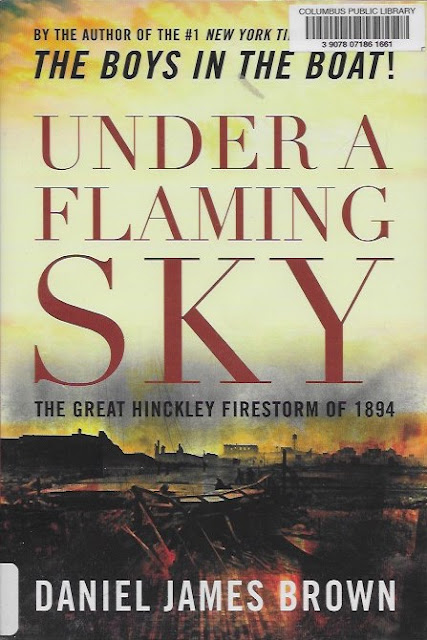This is an impressive book.
In the 1800s, robber barons raped the United States of its virgin forests. The process which started in the Northeast had spread to the Midwest by the 1870s. Forests were not only clearcut, but after separating the trunks from the crown and branches, the timber crews left the "slash" behind in massive tangles of deadwood that stretched for hundreds of miles.
In 1871 drought and high temperatures had turned the harvested forests of northern Wisconsin into tinder, and a massive fire obliterated the town of Peshtigo, killing 1200 people - a tragedy mostly overlooked by news reporters and history, because the Great Chicago Fire happened on the same day.
By 1894 there had been zero improvement in stewardship of the land, and the harvesting of the forests had moved west to Minnesota. This time the victims were in Hinckley and Sandstone, communities just south of Duluth.
This book provides a detailed account of the conflagration. It begins with a couple chapters of backstory on the communities and citizens, the timber industry, and pioneer life in the northwoods. What impressed me was the detail the author provides regarding hour-by-hour movements of the victims and their actual conversations, which he gleaned from extensive research into first-person accounts collected by news reporters and preserved in diaries and correspondence of the survivors.
This was not just a "forest fire" - it was a "firestorm," in which the massive heat (1600-2000 degrees Fahrenheit) creates its own weather, with fire tornadoes and hurricane-force winds. I was particulary awed by the report of one man who took his family to seeming safety in a boat on a lake; the convective forces of the fire column pulled in surrounding air so fiercely that their boat was blown back to the flaming shore, where they perished.
The details are brutal:
(after the fire) "First, they came across the half-burned trunk of Peter Englund lying in his front yard. Then, when they approached Englund's well, they were met by an overwhelming stench. Peering down into the well, they could make out the top layer of what would turn out to be a stack of eighteen bodies - Englund's wife and his seven children and nine other people, most of them neighborhood children..."After the fire, trainloads of sightseers came to gawk at the devastation, including ghoulish opportunists who scavenged the wasteland for safes and cashboxes, stripping jewelry from the bloated corpses.
This is not a "pleasant" read, but the book is well-written and the accounts, while grim, do not seem exploitative or sensationalized. I found a copy at our local library, planning to browse it, but wound up reading cover-to-cover in a couple evenings. It is perhaps better reading for a beach vacation than at a cabin in the woods.
More reading on The Great Hinckley Fire, The Hinckley Fire Museum, and firestorms in general.

I ready nothing but fiction and have been thinking I should start something non-fiction. This looks like a good spot to start -- I just reserved it at my library. Thanks!
ReplyDeleteI'm so glad to hear that. And (if you like it) you might then check out this subsection of the blog -
Deletehttp://tywkiwdbi.blogspot.com/search/label/recommended%20books
:-)